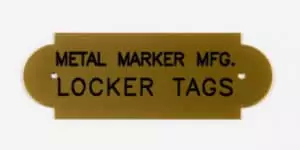Embossing and engraving are two commonly utilized metal tag marking processes.
Raised embossed characters are very easy to read, and demonstrate the highest level of durability. Designs which are engraved are also tough, and fully customizable.
Selecting the right process for your application is crucial for a successful identification solution.
Embossing
embossThe embossing process utilizes a custom die set to mark the information in a metal substrate. This permanent indentation is created using a male-female die in an industrial press. Unlike stamping, embossed information is raised upwards in the material.
Raised designs provide unrivaled durability, accompanied by high visibility. The stand-out characters are easy to read, even from a distance.

For a large-scale production run of a single design, a custom embossing die is produced. This can produce as many nameplates of the same design as necessary.
However, if you need tags with different designs, a new die would need to be made for each new design.
Creating many dies is incredibly costly. As such, variable data embossing machines are often used in this situation.
Embossing Machines
Embossing machines are heavily utilized for the in-house marking of nameplates. Instead of stamping information by hand, an auto-feed system can grab blank metal tags and mark them with custom info.
In addition, the machines are used when creating variable data tags. This is a much more cost-effective method.
Durability
Embossing is one of the most durable marking solutions. The raised characters it produces will not succumb to typical wear, even in tough environments.
The tags are relied upon for some of the harshest industrial conditions. From factories to oil refineries, ships, and utility poles; embossed nameplates are proven to hold up.
Outdoor durability is not a concern with this process. Frequently used outdoors, embossing holds up to rain, wind, and snow. Since there is no surface printing or ink, the design will not rub off or fade from UV light exposure.
Even if the tags become covered with dirt or oil, they will still remain legible due to the raised nature of the characters.
Paint can be a major problem if it conceals the information on your placards. However, embossed tags don’t suffer from this same fallback. The raised characters stay easy to read even after being painted over.
Material
Aluminum
Aluminum is one of the main materials used for this type of nameplate. It is often preferred due to its high durability, yet lightweight nature. This material provides clear impressions when marked by an embossing press.
Anodized aluminum has the upside of additional corrosion resistance, raising the level of durability for the tag. Another major benefit is the option to add a solid color to the tags. This is frequently used for color coordination, i.e. to mark different types of valves.
Stainless Steel
When durability is the most important factor, stainless steel is a solid option. This material can withstand the harshest industrial conditions it is subjected to. This includes weather, extreme temperatures, and wear.
Applications
- Safety Release Valve Tags
- Metal Asset Tags
- Telephone Pole Tags
- Super Elevation Markers
- And More
Customization
Embossed nameplates feature some customizable elements. If a custom logo is needed, a die set can be produced to create it. However, highly intricate designs do not emboss well; simple logos are best.
Color can be added through anodized aluminum as mentioned. In addition, painted steel can be used to create a durable look with a painted appearance.
Engraving
The engraving process differs from the embossing. Instead of a die set pressing a design into the material, engraving uses a tool or laser to directly cut a design in the metal.
The design is carved deep into the substrate, resulting in very clear and easy-to-read information. This deep cut provides significant durability, as it will not be removed with typical wear.

Another benefit to engraving is that the design can be fully customized. Embossed tags are limited to a single custom die set produced. Multiple designs require multiple dies. Whereas engraving can mark a different design on each tag.
While engraving does have positive elements, there is a potentially big drawback: the process is extremely slow. Each design feature must be cut out of every tag individually. This makes marking large quantities of nameplates very time-consuming.
This limitation is a non-ideal solution for large marking tasks. Not only will it take a considerable amount of time, but will also be expensive in comparison to other marking processes.
Durability
As mentioned, engraved identification tags are a resilient marking solution. The deep impression requires a great deal of wear before it will be removed.
In addition, the design is physically marked in the metal material itself. This means there is no additional ink or printing on the surface. Since there is no topical ink, fading or rubbing away is not a concern. The engraved plates can be used in most industrial environments.
Industries
- Telecommunications
- Energy
- Defense
- Many More
Material
A variety of metal materials are used for engraving information. Engraving typically requires the use of thicker material as the impression it makes is deeper than comparable processes.
Aluminum is a commonly used substrate due to its lightweight and durable nature. The addition of corrosion resistance and color-coding via anodization are other contributing factors.
Stainless steel is also a popular option, due to its extreme durability. However, this may lead to a heavier nameplate, especially with the thickness requirement for this process. For many applications, this is not a concern, but some industries have strict weight tolerances for parts.
Other materials are also used for specific properties. For example, brass is sometimes selected for its unique conductive properties or golden-like appearance.
Wrap-Up
Embossing and engraving are two excellent marking solutions. The main difference is the right situation to utilize them.
Embossing
Embossing is one of the most trusted processes for tag marking, and for good reason. It adorns nameplates with extremely durable information and is effective in nearly any environment.
The raised design is suitable for nearly any conditions and remains legible when exposed to liquids and other substances.
Embossed tags are very cost-effective in high quantities, or can be marked in small batches using an embossing machine.
Engraving
Engraved information is long-lasting, and will tolerate a great deal of wear. Keep in mind, this does require a thicker tag material to accommodate the deep impressions.
This process also allows for higher customization, as various designs can be marked on each tag or nameplate.
Engraving is a tedious process, taking a considerable amount of time to mark tags. This makes it less cost-effective for high quantity marking.
While it may not be great for large production runs, engraving is suitable for small quantities.
Ultimately, the right marking process is one that is best suited to your specific application. For high quantities of tags (especially serialized numbers), embossing is your bet.